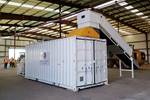Isodan mobile recycling plant supports fiberglass, composites processing at Greater Renewable of Iowa
Now operational, the containerized plant enables GRI to process up to 20,000 pounds of end-of-life wind blades per shift, opening the way for repurposing opportunities.
Isodan Engineering containerized recycling plant installed at GRI. Source (All Images) | Isodan Engineering ApS
In October 2024, Greater Renewable of Iowa (GRI) acquired an Isodan Engineering ApS (Holeby, Denmark) containerized plant — a mobile solution for recycling fiberglass and other composite materials. After mobilization, setup and assistance, the plant is now fully operational and processing wind blades at the GRI facility in Ogden.
Isodan Engineering’s containerized plants aim to repurpose composite materials, driving circularity and eliminating disposal of wind blades in landfills. The system is capable of producing materials between 3-30 millimeters in length that are placed into supersacks for ease in material handling in a dust-free environment. The recycling plants process approximately 20,000 pounds per shift.
On April 8, 2025, representatives from a government agency and engineering department of a local university were present to see the Isodan recycling plant in operation at the GRI facility in Iowa, followed by an open dialogue to explore ways of repurposing these reprocessed wind blades into new products. Presentations on studies and numerous tests on possible ways to repurpose them were presented and discussed.
Discussions held in early April considering repurposing opportunities.
One way in which recycled wind blades are being reused is as an energy source for the production of portland cement — a common type of cement used globally. This process replaces raw materials such as sand and clay, reducing COâ‚‚ emissions and conserving natural resources. In addition, researchers in China have developed methods to integrate processed blade materials into asphalt, enhancing road durability and reducing waste. Due to the large amounts of fines and dust in processed wind blades, caution for repurposing methods is advised to minimize possible health risk.
Also discussed was fiberglass and concrete roofing concept developer ’s (Garrison, N.Y., U.S.) patented design for a stay-in-place (SIP) formwork system currently being 3D printed and tested at the University of Maine’s Advanced Structures and Composites Center under grant money awarded by the U.S. Department of Energy (DOE). This geometry, with a vaulted shape form, can reinforce concrete flatwork, reducing the amount of concrete and steel reinforcement required. These permanent structures — ranging from 4-8 meters in size — comprise a minimum of 30% recycled fiber-reinforced polymers, presenting an opportunity for consumption of large amounts of processed wind blades.
In addition to these examples, Isodan says assessments are being explored for processed blade fibers use in manufacturing composite building materials, components for vehicles and sports equipment, offering alternative lightweight and durable material alternatives. Conenor Ltd. (Lahti, Finland) is cited as one such company that features patented processes in this regard.
Related Content
-
All-recycled, needle-punched nonwoven CFRP slashes carbon footprint of Formula 2 seat
Dallara and Tenowo collaborate to produce a race-ready Formula 2 seat using recycled carbon fiber, reducing CO2 emissions by 97.5% compared to virgin materials.
-
ASCEND program completion: Transforming the U.K.'s high-rate composites manufacturing capability
GKN Aerospace, McLaren Automotive and U.K. partners chart the final chapter of the 4-year, £39.6 million ASCEND program, which accomplished significant progress in high-rate production, Industry 4.0 and sustainable composites manufacturing.
-
Life cycle assessment in the composites industry
As companies strive to meet zero-emissions goals, evaluating a product’s carbon footprint is vital. Life cycle assessment (LCA) is one tool composites industry OEMs and Tier suppliers are using to move toward sustainability targets.



